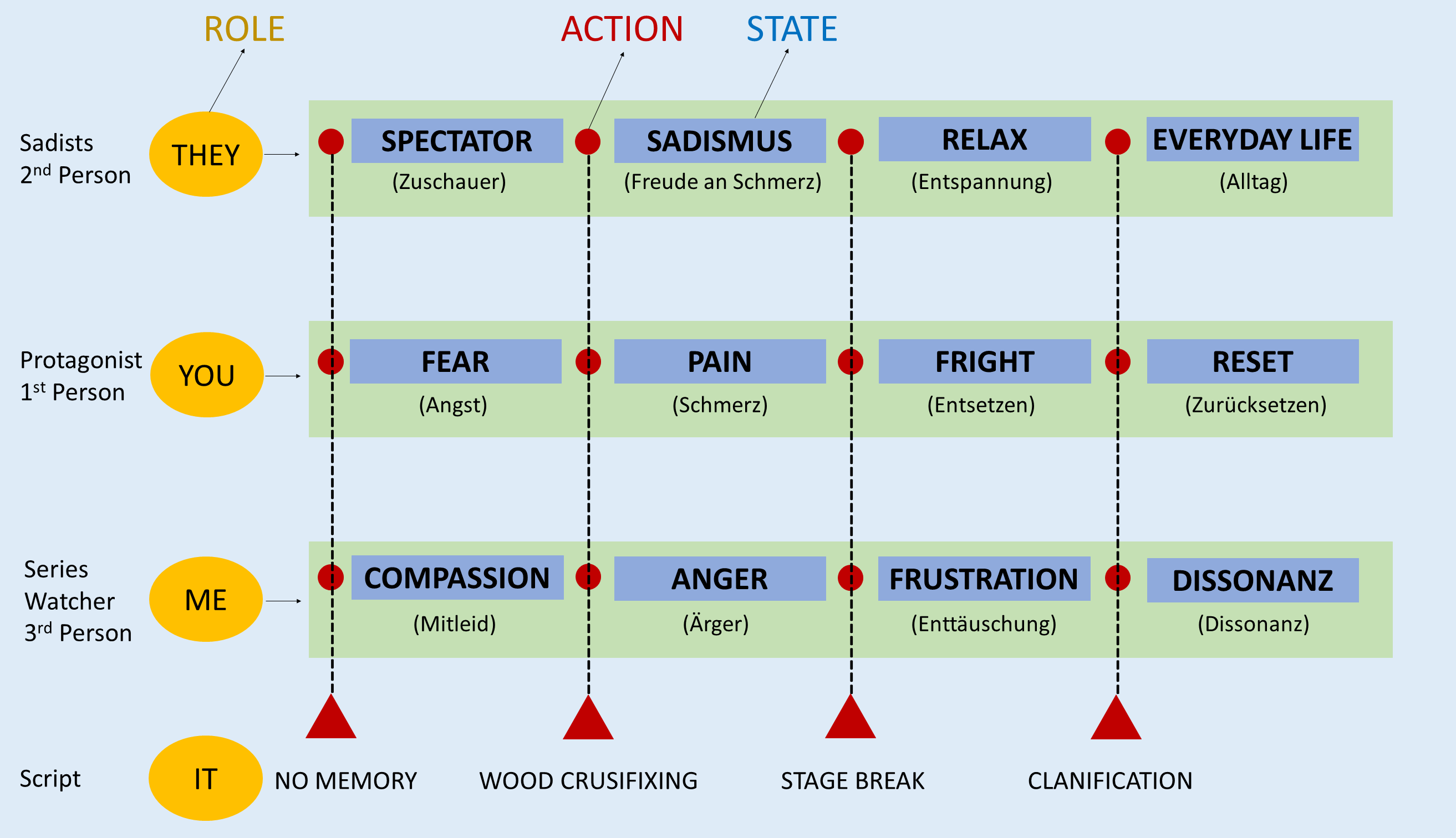Values: Third Person
The protagonist plays a nameless young woman who cannot remember anything and also does not know who she is anymore. She detects signs of injury on her wrist and sees tablets lying on the floor. The assumption is obvious that she has survived a suicide attempt – but she is not sure. So she starts to look around and leaves her house. She notes that she is being watched from all sides. Mainly it is filmed by onlookers with smartphones. Behind all the windows she recognizes onlookers. Nobody reacts to their helplessness. She starts to run and the “pack” pursues her. Similar to paparazzi who pursue their victims.
Very quickly it turns out that there are two roles in this episode. First, it is the young woman who cannot remember anything, and second, the onlookers. Surely someone has written a script. Finally there is the audience, in this case me, who is watching the episode. In the first phase I experience in myself compassion for the young woman. At the time, the script did not give me much clues, except that she cannot remember anything and is being followed by a group of onlookers. Spoiler warning: Now is the right time to watch the series, because the further considerations in the blog only work, if one has seen the episode unconsciously.
Systematically, it is the four roles It-You-You-Me. Then there is the script, which provides for events, from which then different states arise with the individual actors.
The story develops and the young woman supposedly gets help and a new event develops: she is led blindfolded into a forest and there she sees people crucified on trees. In me (3rd person), compassion changes to anger. In the protagonist (1st person), fear becomes pain. She is already tied to a tree trunk. The viewers (2nd person) are coming more and more to their climax. In that sense, as they rejoice over the pain of the young woman. The pleasure they have: because they see another person in pain; typical sadists.
Somehow, the protagonist manages to free herself again, an accomplice helps her escape and both together they try to turn off the monitoring devices within a building. Suddenly and completely unexpectedly, a wall opens and the protagonist finds herself on a stage before applauding spectators. The presenter explains who she really is, namely a criminal who helped with the murder of a child. As proof of this, her film and footage will be played. During that, the memories come back. In the meantime, disappointment is released in me (3rd person). I am frustrated because the persecuted suddenly becomes the defendant. She herself (1st person) is appalled at herself and after the sadistic climax, the spectators relax.
Actually, the story could be over here, if not there was the credits. We are informed that there is a special criminal case for defendants in the future shown. The “murderess” has to make a painful and painful experience as a punishment. Pain that she has to relive every day. In order for this to be possible, her memories will soon be erased by a painful procedure as well. So every day in the morning the pain can start again. What we still learn in the credits is that these torments always take place in public. As part of a show, spectators are invited to accompany them on the ordeal. This realization leads to a dissonance with me (3rd person). My feelings turned to disappointment while watching from compassion to anger. The 1st person’s feelings have changed from fear to pain to horror. The voyeurs experienced curiosity, satisfaction and relaxation. The script with the four main events memory loss, crucifixion, stage break and clarification have created completely different experiences in the three roles.
To enjoy other people’s pains is well known and commonly referred to as sadism. This predisposition can always be seen well in the real world in accidents and disasters. An aggravation of this behavior comes with the ubiquity of filming and photographing smartphone owners added. Suffering becomes public and spreads rapidly via social media. Currently we have seen this with the included football team in Thailand. A group of young boys did a cave expedition with their trainer and were included. The whole world was able to watch the bailout online. Yes – there were twelve people in mortal danger. At the same time, there were hundreds of refugees on the Mediterranean who drowned on the crossing and no one had any attention for it. In the episode 3 script it is very well possible to show the human need for curiosity, curiosity, glee, and ultimately sadism. This expedition is particularly well suited for self-observation. As a viewer in front of the TV you can see spectators who satisfy their “perverse” needs. Through the storyline and with the enlightenment in the credits a mirror is held up and the 3rd person becomes the 2nd person.
The position of the 3rd person is a very difficult one. In psychological therapy work, it is used whenever you want to work through difficult, painful situations. One can bring about this mechanism in a mental state by seeing oneself in the “painful situation” without experiencing the feelings so intensely again.
A special mental capacity is now to switch between the individual roles. You can also play through your own effect on others and third parties. This methodology is used by presenters and speakers to test the impact of their presentation. Another peculiarity, the punishment of criminals, is addressed in this episode. Prison execution in liberal societies has two ramifications: on the one hand, people who are behaving in a criminal manner must be removed from society – that is prison sentences – and, on the other, the measure should be used to prevent crime. It is not meant to be “the same with the same”. In western, liberal societies a self-justice is not provided. We measured ourselves also not to be the personal judge of others. All the more astonishing in this episode is the penitentiary aimed at suffering pain from the offender. However, this method is not very new, but has been used for thousands of years as an instrument of punishment. In the so-called dark Middle Ages, the “high-pitched” questioning, the torture, was used even before a person was criminal. Is still used today in absolutist and religiously fundamentalist dominated societies.
The episode shows how fast an obviously clear situation can completely turn. It is then those cases that we personally experience as dissonance – something that is completely different than what we expect.





 Deutsch
Deutsch English
English